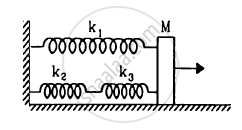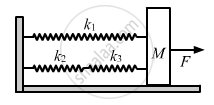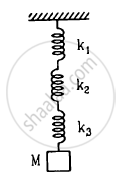Advertisements
Advertisements
Question
The springs shown in the figure are all unstretched in the beginning when a man starts pulling the block. The man exerts a constant force F on the block. Find the amplitude and the frequency of the motion of the block.

Solution

As the block of mass M is pulled, a net resultant force is exerted by the three springs opposing the motion of the block.
Now, springs k2 and k3 are in connected as a series combination.
Let k4 be the equivalent spring constant.
\[\therefore \frac{1}{k_4} = \frac{1}{k_2} + \frac{1}{k_3} = \frac{k_2 + k_3}{k_2 k_3}\]
\[ k_4 = \frac{k_2 k_3}{k_2 + k_3}\]
k4 and k1 form a parallel combination of springs. Hence, equivalent spring constant k = k1 + k4.
\[= \frac{k_2 k_3}{k_2 + k_3} + k_1 \]
\[ = \frac{k_2 k_3 + k_1 k_2 + k_1 k_3}{k_2 + k_3}\]
\[ \therefore \text { Time peiod }, T = 2\pi\sqrt{\frac{M}{k}}\]
\[ = 2\pi\sqrt{\frac{M \left( k_2 + k_3 \right)}{k_2 k_3 + k_1 k_2 + k_1 k_3}}\]
(b) Frequency \[\left( v \right)\] is given by,
\[v = \frac{1}{T}\]
\[= \frac{1}{2\pi}\sqrt{\frac{k_2 k_3 + k_1 k_2 + k_1 k_3}{M\left( k_2 + k_3 \right)}}\]
(c) Amplitude ( x ) is given by,
\[x = \frac{F}{k} = \frac{F\left( k_2 + k_3 \right)}{k_1 k_2 + k_2 k_3 + k_1 k_3}\]
APPEARS IN
RELATED QUESTIONS
A particle is in linear simple harmonic motion between two points, A and B, 10 cm apart. Take the direction from A to B as the positive direction and give the signs of velocity, acceleration and force on the particle when it is
(a) at the end A,
(b) at the end B,
(c) at the mid-point of AB going towards A,
(d) at 2 cm away from B going towards A,
(e) at 3 cm away from A going towards B, and
(f) at 4 cm away from B going towards A.
The maximum speed and acceleration of a particle executing simple harmonic motion are 10 cm/s and 50 cm/s2. Find the position(s) of the particle when the speed is 8 cm/s.
Consider a particle moving in simple harmonic motion according to the equation x = 2.0 cos (50 πt + tan−1 0.75) where x is in centimetre and t in second. The motion is started at t = 0. (a) When does the particle come to rest for the first time? (b) When does he acceleration have its maximum magnitude for the first time? (c) When does the particle come to rest for the second time ?
A block suspended from a vertical spring is in equilibrium. Show that the extension of the spring equals the length of an equivalent simple pendulum, i.e., a pendulum having frequency same as that of the block.
A block of mass 0.5 kg hanging from a vertical spring executes simple harmonic motion of amplitude 0.1 m and time period 0.314 s. Find the maximum force exerted by the spring on the block.
A body of mass 2 kg suspended through a vertical spring executes simple harmonic motion of period 4 s. If the oscillations are stopped and the body hangs in equilibrium find the potential energy stored in the spring.
Repeat the previous exercise if the angle between each pair of springs is 120° initially.
Find the elastic potential energy stored in each spring shown in figure, when the block is in equilibrium. Also find the time period of vertical oscillation of the block.
Find the elastic potential energy stored in each spring shown in figure when the block is in equilibrium. Also find the time period of vertical oscillation of the block.

When a particle executing S.H.M oscillates with a frequency v, then the kinetic energy of the particle?
When the displacement of a particle executing simple harmonic motion is half its amplitude, the ratio of its kinetic energy to potential energy is ______.
A body is executing simple harmonic motion with frequency ‘n’, the frequency of its potential energy is ______.
Motion of an oscillating liquid column in a U-tube is ______.
A body is performing S.H.M. Then its ______.
- average total energy per cycle is equal to its maximum kinetic energy.
- average kinetic energy per cycle is equal to half of its maximum kinetic energy.
- mean velocity over a complete cycle is equal to `2/π` times of its π maximum velocity.
- root mean square velocity is times of its maximum velocity `1/sqrt(2)`.
Find the displacement of a simple harmonic oscillator at which its P.E. is half of the maximum energy of the oscillator.
A mass of 2 kg is attached to the spring of spring constant 50 Nm–1. The block is pulled to a distance of 5 cm from its equilibrium position at x = 0 on a horizontal frictionless surface from rest at t = 0. Write the expression for its displacement at anytime t.
A body of mass m is attached to one end of a massless spring which is suspended vertically from a fixed point. The mass is held in hand so that the spring is neither stretched nor compressed. Suddenly the support of the hand is removed. The lowest position attained by the mass during oscillation is 4 cm below the point, where it was held in hand.
What is the amplitude of oscillation?
